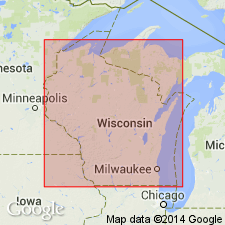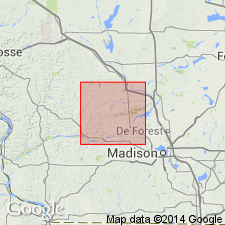
- Usage in publication:
-
- Readstown Member
- Modifications:
-
- Named
- Dominant lithology:
-
- Conglomerate
- AAPG geologic province:
-
- Wisconsin arch
Summary:
Name Readstown Member assigned to basal conglomerate of St. Peter Sandstone. Underlies Tonti Member. Buschbach (1964) proposed name Kress for the conglomerate, but Kress is rejected because the type section is taken from a well near the headwaters of Kress Creek in northeastern IL rather than from an outcrop.
Source: GNU records (USGS DDS-6; Reston GNULEX).

- Usage in publication:
-
- Readstown Member
- Modifications:
-
- Overview
- Dominant lithology:
-
- Breccia
- Sandstone
- AAPG geologic province:
-
- Wisconsin arch
Summary:
In Sauk Co., WI, St. Peter Formation has two recognizable subdivisions: the lower Readstown Member and the upper Tonti Member. Readstown is equivalent to the Kress Member in IL. In area of report, Readstown consists of a few meters of breccia composed of sandstone pebbles, cobbles, and boulders. Matrix is sand, silt and clay. Bedding is irregular and erratic. Bands of nearly black ironstone common. Dark-red iron oxide coating on slickensided surfaces also common. Tonti Member makes up most of the St. Peter in the report area. St. Peter Formation overlies Oneota Formation and underlies Rountree Formation (new name) or Horicon Formation. Age is Middle Ordovician.
Source: GNU records (USGS DDS-6; Reston GNULEX).
For more information, please contact Nancy Stamm, Geologic Names Committee Secretary.
Asterisk (*) indicates published by U.S. Geological Survey authors.
"No current usage" (†) implies that a name has been abandoned or has fallen into disuse. Former usage and, if known, replacement name given in parentheses ( ).
Slash (/) indicates name conflicts with nomenclatural guidelines (CSN, 1933; ACSN, 1961, 1970; NACSN, 1983, 2005, 2021). May be explained within brackets ([ ]).

